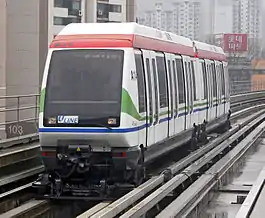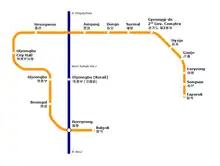| U Line | |
|---|---|
 | |
| Overview | |
| Native name | 의정부경전철 Uijeongbu-Gyeongjeoncheol |
| Status | Operational |
| Termini | |
| Stations | 16[1] |
| Service | |
| Type | Rubber-tyred metro |
| System | Seoul Metropolitan Subway |
| Operator(s) | Uijeongbu Light Rail Transit Co., Ltd |
| Rolling stock | 15 × Siemens VAL 208 U100 |
| History | |
| Opened | 29 June 2012 (trial) 1 July 2012 (revenue)[1] |
| Technical | |
| Line length | 11.3 km (7.0 mi)[1] |
| Number of tracks | 2 |
| Track gauge | 1,620 mm (5 ft 4 in) |
| Electrification | 750 V DC third rail |
| Operating speed | 80 km/h (50 mph) |
The U Line is a driverless, fully automatic, grade-separated light rail[1] or light metro[2][3] line in Uijeongbu, Seoul Capital Area, South Korea. The "U" is short for the city Uijeongbu. The line uses Véhicule Automatique Léger (VAL) 208 trains built by Siemens Transportation Systems. The system is very similar to the Toulouse Metro, Lille Metro and Rennes Metro in France. The line color is amber.
The line is 11.2 km (7.0 mi) long on elevated track[1] and offers a transfer to Line 1 at Hoeryong Station. Single rides cost 1,550 won. During rush hours trains come every 3 and a half minutes with trains coming every 6 to 10 minutes during all other hours. Trains are in service 19.5 hours a day, from 5 am until 12:30 am.[4][5] From Balgok Station to Tapseok Station, the U Line will take riders 19 minutes and 54 seconds, versus a car, at 31 minutes 6 seconds, or a public bus, taking 40 minutes and 6 seconds.[6] Two extensions are planned.[2]
After four and a half years of operating at a continual loss, a debt of 240 billion won prompted board members of the Uijeongbu Light Rail Transit Company to file for bankruptcy in late 2016. If the Seoul Central District Court agrees to the filing then operation reverts to the city government. On 5 January 2017, Uijeongbu Mayor Ahn Byung-yong promised the line would continue operation.[7]
History

- 1995 December – Initial planning
- 2004 August – GS Construction Consortium is picked
- 2005 October – Operating company is established
- 2007 July – Construction groundbreaking ceremony
- 2007 August – Full construction begins
- 2011 Summer – All track has been laid
- 2011 Fall – Signal work completion
- 2012 February to June- Testing of system
- 2012 June 29–30 – Free rides prior to official opening [4]
- 2012 July 1 – Revenue service begins[8]
- 2014 December 6 – Joins metropolitan unity fare allowing transfers to other lines and buses. Fares start from 1,350, with a flat 300 won extra charge if transferring from Line 1.[9]
Fares
The U Line is physically connected to the Seoul Metropolitan Subway system and allows payment via the T-money smart card. It allows transfer to other lines and buses since 6 December 2014.[9] Discounts are available for youth and free rides exist for those over 65 years of age.
Rolling stock
The line uses VAL 208 rolling stock also used on the metros in Lille, Toulouse, Rennes (Line A only), and Turin, as well as the CDGVAL at Charles de Gaulle Airport in Paris. However, unlike those cities, the trains have air conditioning to suit the more humid climate of South Korea.
Stations
There is no station numbered U116.
All stations are in Uijeongbu, Gyeonggi-do.
| Station number |
Station name | Transfer | Station distance |
Total distance | |||||||
|---|---|---|---|---|---|---|---|---|---|---|---|
| Romanized | Hangul | Hanja | in km | ||||||||
| U110 | Balgok | 발곡 | 鉢谷 | --- |
0.0 | ||||||
| U111 | Hoeryong | 회룡 | 回龍 | 0.8 |
0.8 | ||||||
| U112 | Beomgol | 범골 | 범골 | 0.6 |
1.4 | ||||||
| U113 | LRT Uijeongbu | 경전철의정부 | 輕電鐵議政府 | 1.0 |
2.4 | ||||||
| U114 | Uijeongbu City Hall | 의정부시청 | 議政府市廳 | 0.9 |
3.3 | ||||||
| U115 | Heungseon | 흥선 | 興宣 | 0.6 |
3.9 | ||||||
| U117 | Uijeongbujungang | 의정부중앙 | 議政府中央 | 1.1 |
5.0 | ||||||
| U118 | Dongo | 동오 | 東梧 | 0.7 |
5.7 | ||||||
| U119 | Saemal | 새말 | 새말 | 0.8 |
6.5 | ||||||
| U120 | Gyeonggi Provincial Government Northern Office | 경기도청북부청사 | 京畿道廳北部廳舍 | 0.6 |
7.2 | ||||||
| U121 | Hyoja | 효자 | 孝子 | 0.6 |
7.8 | ||||||
| U122 | Gonje | 곤제 | 昆弟 | 0.8 |
8.6 | ||||||
| U123 | Eoryong (Yonghyeon Industrial Complex) |
어룡 (용현산업단지) |
魚龍 | 0.9 |
9.5 | ||||||
| U124 | Songsan | 송산 | 松山 | 0.6 |
10.1 | ||||||
| U125 | Tapseok | 탑석 | 塔石 | 0.5 |
10.6 | ||||||
| U126 | Depot Temporary Platform (Cultural Convergence Complex) |
차량기지 임시승강장 (복합문화융합단지) |
車輛基地臨時昇降場 | 0.7 |
11.3 | ||||||
See also
References
- 1 2 3 4 5 "Uijeongbu Light Rail Transit, South Korea". railway-technology.com. Retrieved 22 February 2014.
- 1 2 David Briginshaw (2 July 2012). "Korean city opens automatic light metro". International Railway Journal. Retrieved 10 July 2012.
- ↑ Michael Taplin (March 2013). "Home – World Systems List index – World List K-O – Korea South (KR)". Light Rail Transit Association (LRTA). Archived from the original on 6 April 2019. Retrieved 7 August 2014.
- 1 2 의정부경전철 개통 및 이용안내 [Opening Info] (in Korean). U Line. Archived from the original on 28 February 2014. Retrieved 2 July 2012.
- ↑ 운영정보 [Operating Info] (in Korean). U Line. Archived from the original on 28 February 2014. Retrieved 2 July 2012.
- ↑ 노선안내 [Time differences and station names] (in Korean). U Line. Archived from the original on 6 April 2016. Retrieved 2 July 2012.
- ↑ "Uijeongbu light rail files for bankruptcy". Korea Joongang Daily. 12 January 2017. Retrieved 13 January 2017.
- ↑ 시행사소개 [History page] (in Korean). U Line. Archived from the original on 1 November 2014. Retrieved 2 July 2012.
- 1 2 "의정부경전철". Archived from the original on 2016-03-05. Retrieved 2014-12-05.
External links
- U Line – official website (in Korean)
- Uijeongbu VAL system at UrbanRail.Net
- U Line Naver Blog (in Korean)